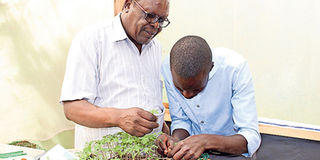How I beat tomato bacterial wilt

Gideon Too and agronomist Titus Tanui graft tomato seedlings in Nandi County. Grafting helps to control pests and diseases such as nematodes, fusarium as well as bacterial wilt which is major challenge to most farmers. PHOTO | STANLEY KIMUGE | NMG
What you need to know:
- Too, who owns the 10-acre farm situated a kilometre from Chepterit junction along the Kapsabet-Eldoret Road, has been growing tomatoes in an 8 by 20m greenhouse since 2014.
- In 2017, he learnt of an Asian tomato variety known as Shin Cheong Gang that is tolerant to bacteria wilt. The tomato plant grows up to 17 feet, has deep-root development as well as elongates the harvest time from usual three months to between nine to 10 months.
- He notes that the variety produces tasty but smaller fruit sizes compared to new varieties such as the Anna F1. And to achieve desired size for his market, he grafts them.
- Carol Mutua, a horticulture specialist from Egerton University, says Cheong Gang tomato variety originated from Asia through a breeding programme but is available from Seminis Seed Company.
Standing next to a tray with tiny tomato plants, Titus Tanui uproots one of them then picks a razor blade, slices it into half and then uproots another plant and repeats the process.
The 32-year-old then uses a plastic rope to bind the two pieces. “The upper one is the scion while the lower is the rootstock. The plants look the same but they are from two tomato varieties. I normally leave the new plant for two days to heal. If it wilts, I know that it has not healed,” explains Tanui as Gideon Too, a farmer, follows the process.
Tanui, a general agriculture student at Kaiboi Technical Training Institute in Uasin Gishu, explains that the plants are then placed in a healing chamber for three weeks before they are planted in the greenhouse.
At about two-and-half months, one begins to harvest the crop for the next seven months.
Too, who owns the 10-acre farm situated a kilometre from Chepterit junction along the Kapsabet-Eldoret Road, has been growing tomatoes in an 8 by 20m greenhouse since 2014.
However, soon after, he encountered bacteria wilt (Ralstonia solanacearum) that made him harvest losses. Initially, he had projected to earn Sh300,000 from the venture but lost Sh240,000 to the disease.
“I was advised to go to the forest to source another growing media but it didn’t salvage the situation. I went to Kimondi Forest and brought a lorry full of soil which I used to plant my tomatoes but the situation was the same,” recounts the farmer, who worked in both public and private sectors before retiring as the chief executive of the Kenya Tea Growers Association in 2010.
He realised that bacterial wilt had become a thorn in the flesh of most farmers in the area. “We had 18 greenhouses in the neighbourhood where farmers planted tomatoes but abandoned the agribusiness due to bacteria wilt.”
In 2017, he learnt of an Asian tomato variety known as Shin Cheong Gang that is tolerant to bacteria wilt. The tomato plant grows up to 17 feet, has deep-root development as well as elongates the harvest time from usual three months to between nine to 10 months.
USE RESISTANT ROOTSTOCK
The 64-year-old grafted Cheong Gang, and the local Anna FI variety, using the former as the rootstock. He planted 600 tomatoes seedlings in February, 2017, and was amazed that the crop was not attacked by bacteria wilt.
“I had a good yields for the first time in years. On average, each tomato plant produced over 100 fruits at the end of that season. I uprooted the crop and planted again last February in the same greenhouse and I thought the production would go down but it was the same,” says the farmer.
He notes that the variety produces tasty but smaller fruit sizes compared to new varieties such as the Anna F1. And to achieve desired size for his market, he grafts them.
“There is a huge demand for tomatoes in hotels at Kapsabet Town and traders also come for them from Eldoret. A small crate holding 20kg of tomatoes goes from Sh1,500 and Sh3,000 depending on the season.”
Too says he has also started to graft the wild tomato variety with local ones.
He has since put up two more greenhouses measuring 30 by 8m and also grows strawberries, broccoli, egg plants, capsicum, cinnamon, bananas and rears poultry, dairy cows and goats.
Carol Mutua, a horticulture specialist from Egerton University, says Cheong Gang tomato variety originated from Asia through a breeding programme but is available from Seminis Seed Company.
“It is advisable to use a resistant rootstock against soil-borne diseases like bacterial wilt. Cheong Gang tomato variety is highly tolerant to bacterial wilt and its rootstock has been used in the management of the disease.”
Jared Mutai, the deputy county director of agriculture in-charge of horticultural crops in Nandi County, advises that farmers can go for the wild varieties of the plants that belong to same family with the tomatoes.
“Grafting helps to control pests and diseases such as nematodes, fusarium as well as bacterial wilt which is major challenge to most farmers. But from a research we conducted, farmers can also use crops such as wild eggplant, (the bitter tomato) species which reduces bacterial wilt incidences by 100 per cent,” says Mutai.





